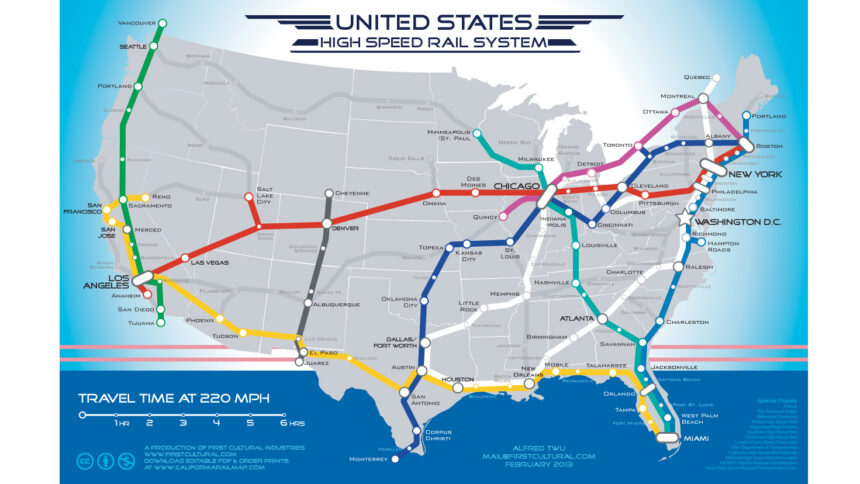US High-Speed Rail Initiatives: Progress and Challenges
The United States, home to 340 million inhabitants, 71 interstate highways, and over 5,000 public airports, currently lacks a high-speed rail network. However, with two high-speed rail (HSR) projects in progress and more anticipated, there are signs that America could be progressing toward a rail system comparable to those in Europe, China, and Japan.
Current Projects
According to Rick Harnish from the High Speed Rail Alliance, the initiation of the first two HSR projects marks a significant step forward. One is the ambitious route connecting San Francisco and Los Angeles, which presents unique construction challenges due to California’s mountainous terrain. A second, less complex project, is the Las Vegas to Los Angeles line, which traverses flatter land.
Additional plans involve a rail line stretching from Portland, Oregon, to Seattle, Washington, extending further to Vancouver, Canada, and another line linking Dallas to Houston. Despite these projects, Harnish cautions that progress, especially on the Portland to Seattle line, is stagnating, and further uncertainty looms over the Texas project following the cancellation of a crucial federal grant by the Trump administration.
A Global Perspective
In stark contrast to the U.S., China’s high-speed rail network is expected to surpass 50,000 km (31,000 miles) by the end of this year. Europe isn’t far behind, with the EU housing 8,556 km of high-speed railways, including Spain’s extensive 3,190 km. The UK’s sole HSR line, High Speed 1, connects the Channel Tunnel to London, while High Speed 2 continues to progress between London and Birmingham.
Though a precise definition of high-speed rail varies, the International Union of Railways generally requires trains to exceed speeds of 250 km/h (155 mph). The U.S. continues to lag behind due to a longstanding cultural preference for automobile travel, explains rail industry expert Will Doig.
Challenges Ahead
In recent developments, Stephen Gardner, the chief of Amtrak, resigned amid speculated pressures from the White House. Currently, Amtrak does not operate any HSR trains but is set to introduce 28 new 160 mph NextGen Acela trains, albeit with only 50 miles of its 457-mile Northeast Corridor allowing speeds above 150 mph.
The state of California is leading the construction of the high-speed line from Los Angeles to San Francisco, projected for completion by 2033. Meanwhile, Brightline West, a privately run project connecting Las Vegas to Los Angeles, anticipates an opening in 2028.
| Project | Route | Projected Completion |
|---|---|---|
| California High-Speed Rail | Los Angeles – San Francisco | 2033 |
| Brightline West | Las Vegas – Los Angeles | 2028 |
The Path Forward
As various nations advance their HSR initiatives, the U.S. faces numerous obstacles, including political resistance to public investment in rail systems. Harnish asserts that federal support is essential for the successful implementation of HSR in America, yet skepticism remains, especially following the White House’s decision to withdraw funding for the Houston-Dallas line, deemed a waste of taxpayer funds by Transportation Secretary Sean Duffy.
With China continuing to expand its own high-speed rail network and offering assistance to countries in Southeast Asia, Doig expresses hope for potential collaboration between the U.S. and China on HSR projects. However, the current geopolitical climate creates significant challenges to such partnerships.
Ultimately, the development of a comprehensive high-speed railway in the U.S. may depend on a fundamental shift in public sentiment favoring mass transit over automobile dependency, as the nation contemplates its future infrastructure priorities.




